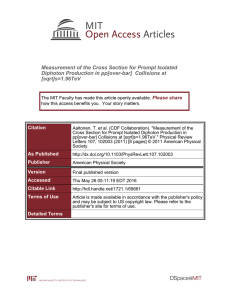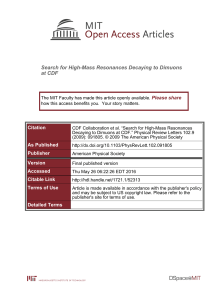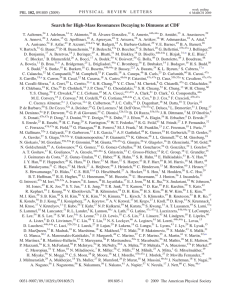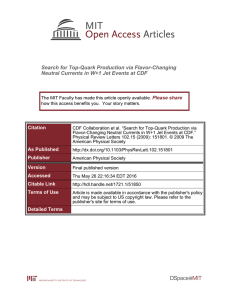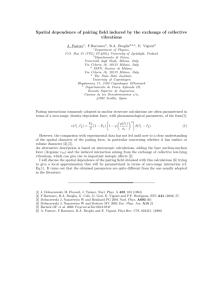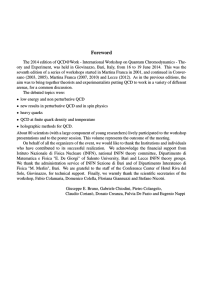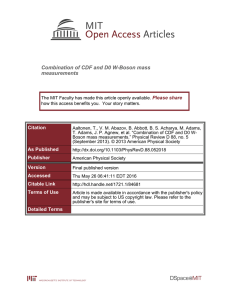First Measurement of the Angular Coefficients of Drell-Yan
advertisement
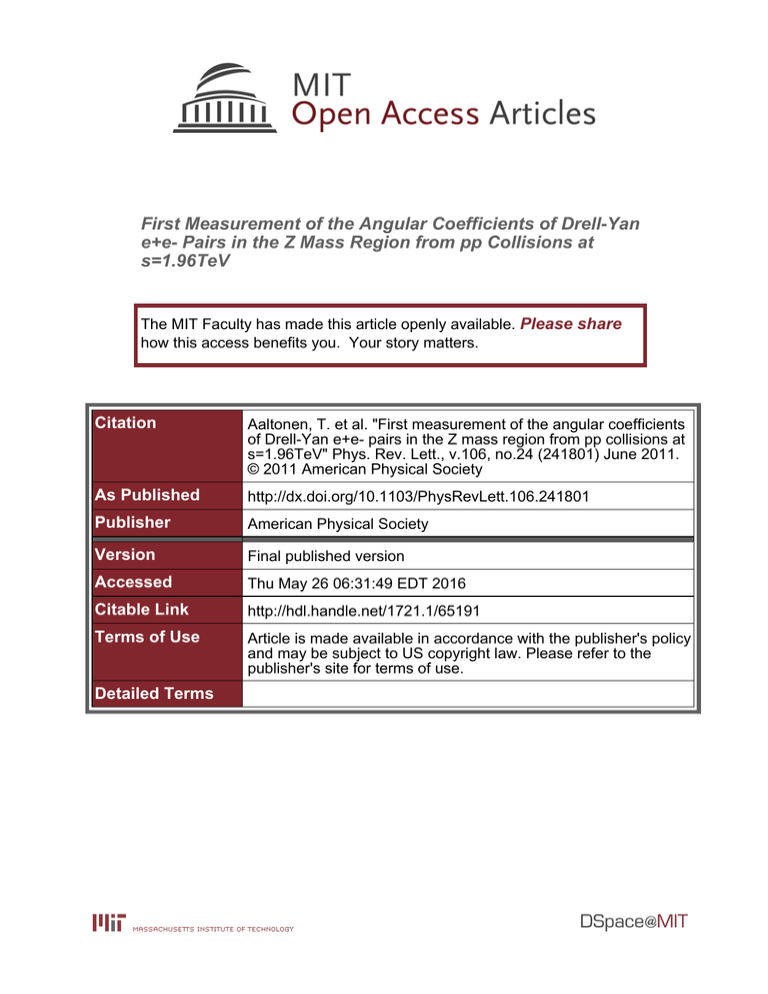
First Measurement of the Angular Coefficients of Drell-Yan e+e- Pairs in the Z Mass Region from pp Collisions at s=1.96TeV The MIT Faculty has made this article openly available. Please share how this access benefits you. Your story matters. Citation Aaltonen, T. et al. "First measurement of the angular coefficients of Drell-Yan e+e- pairs in the Z mass region from pp collisions at s=1.96TeV" Phys. Rev. Lett., v.106, no.24 (241801) June 2011. © 2011 American Physical Society As Published http://dx.doi.org/10.1103/PhysRevLett.106.241801 Publisher American Physical Society Version Final published version Accessed Thu May 26 06:31:49 EDT 2016 Citable Link http://hdl.handle.net/1721.1/65191 Terms of Use Article is made available in accordance with the publisher's policy and may be subject to US copyright law. Please refer to the publisher's site for terms of use. Detailed Terms PRL 106, 241801 (2011) PHYSICAL REVIEW LETTERS week ending 17 JUNE 2011 First Measurement of the Angular Coefficients of p Drell-Yan eþ e Pairs in the ffiffiffi Z Mass Region from pp Collisions at s ¼ 1:96 TeV T. Aaltonen,21 B. Álvarez González,9,x S. Amerio,41a D. Amidei,32 A. Anastassov,36 A. Annovi,17 J. Antos,12 G. Apollinari,15 J. A. Appel,15 A. Apresyan,46 T. Arisawa,56 A. Artikov,13 J. Asaadi,51 W. Ashmanskas,15 B. Auerbach,59 A. Aurisano,51 F. Azfar,40 W. Badgett,15 A. Barbaro-Galtieri,26 V. E. Barnes,46 B. A. Barnett,23 P. Barria,44b,44a P. Bartos,12 M. Bauce,41b,41a G. Bauer,30 F. Bedeschi,44a D. Beecher,28 S. Behari,23 G. Bellettini,44b,44a J. Bellinger,58 D. Benjamin,14 A. Beretvas,15 A. Bhatti,48 M. Binkley,15,a D. Bisello,41b,41a I. Bizjak,28,bb K. R. Bland,5 B. Blumenfeld,23 A. Bocci,14 A. Bodek,47 D. Bortoletto,46 J. Boudreau,45 A. Boveia,11 B. Brau,15,b L. Brigliadori,6b,6a A. Brisuda,12 C. Bromberg,33 E. Brucken,21 M. Bucciantonio,44b,44a J. Budagov,13 H. S. Budd,47 S. Budd,22 K. Burkett,15 G. Busetto,41b,41a P. Bussey,19 A. Buzatu,31 C. Calancha,29 S. Camarda,4 M. Campanelli,33 M. Campbell,32 F. Canelli,11,15 A. Canepa,43 B. Carls,22 D. Carlsmith,58 R. Carosi,44a S. Carrillo,16,l S. Carron,15 B. Casal,9 M. Casarsa,15 A. Castro,6b,6a P. Catastini,15 D. Cauz,52a V. Cavaliere,44b,44a M. Cavalli-Sforza,4 A. Cerri,26,g L. Cerrito,28,r Y. C. Chen,1 M. Chertok,7 G. Chiarelli,44a G. Chlachidze,15 F. Chlebana,15 K. Cho,25 D. Chokheli,13 J. P. Chou,20 W. H. Chung,58 Y. S. Chung,47 C. I. Ciobanu,42 M. A. Ciocci,44b,44a A. Clark,18 G. Compostella,41b,41a M. E. Convery,15 J. Conway,7 M. Corbo,42 M. Cordelli,17 C. A. Cox,7 D. J. Cox,7 F. Crescioli,44b,44a C. Cuenca Almenar,59 J. Cuevas,9,x R. Culbertson,15 D. Dagenhart,15 N. d’Ascenzo,42,v M. Datta,15 P. de Barbaro,47 S. De Cecco,49a G. De Lorenzo,4 M. Dell’Orso,44b,44a C. Deluca,4 L. Demortier,48 J. Deng,14,d M. Deninno,6a F. Devoto,21 M. d’Errico,41b,41a A. Di Canto,44b,44a B. Di Ruzza,44a J. R. Dittmann,5 M. D’Onofrio,27 S. Donati,44b,44a P. Dong,15 M. Dorigo,52a T. Dorigo,41a K. Ebina,56 A. Elagin,51 A. Eppig,32 R. Erbacher,7 D. Errede,22 S. Errede,22 N. Ershaidat,42,aa R. Eusebi,51 H. C. Fang,26 S. Farrington,40 M. Feindt,24 J. P. Fernandez,29 C. Ferrazza,44b,44c,44d R. Field,16 G. Flanagan,46,t R. Forrest,7 M. J. Frank,5 M. Franklin,20 J. C. Freeman,15 Y. Funakoshi,56 I. Furic,16 M. Gallinaro,48 J. Galyardt,10 J. E. Garcia,18 A. F. Garfinkel,46 P. Garosi,44b,44c H. Gerberich,22 E. Gerchtein,15 S. Giagu,49b,49a V. Giakoumopoulou,3 P. Giannetti,44a K. Gibson,45 C. M. Ginsburg,15 N. Giokaris,3 P. Giromini,17 M. Giunta,44a G. Giurgiu,23 V. Glagolev,13 D. Glenzinski,15 M. Gold,35 D. Goldin,51 N. Goldschmidt,16 A. Golossanov,15 G. Gomez,9 G. Gomez-Ceballos,30 M. Goncharov,30 O. González,29 I. Gorelov,35 A. T. Goshaw,14 K. Goulianos,48 S. Grinstein,4 C. Grosso-Pilcher,11 R. C. Group,55,15 J. Guimaraes da Costa,20 Z. Gunay-Unalan,33 C. Haber,26 S. R. Hahn,15 E. Halkiadakis,50 A. Hamaguchi,39 J. Y. Han,47 F. Happacher,17 K. Hara,53 D. Hare,50 M. Hare,54 R. F. Harr,57 K. Hatakeyama,5 C. Hays,40 M. Heck,24 J. Heinrich,43 M. Herndon,58 S. Hewamanage,5 D. Hidas,50 A. Hocker,15 W. Hopkins,15,h D. Horn,24 S. Hou,1 R. E. Hughes,37 M. Hurwitz,11 U. Husemann,59 N. Hussain,31 M. Hussein,33 J. Huston,33 G. Introzzi,44a M. Iori,49b,49a A. Ivanov,7,p E. James,15 D. Jang,10 B. Jayatilaka,14 E. J. Jeon,25 M. K. Jha,6a S. Jindariani,15 W. Johnson,7 M. Jones,46 K. K. Joo,25 S. Y. Jun,10 T. R. Junk,15 T. Kamon,51 P. E. Karchin,57 A. Kasmi,5 Y. Kato,39,o W. Ketchum,11 J. Keung,43 V. Khotilovich,51 B. Kilminster,15 D. H. Kim,25 H. S. Kim,25 H. W. Kim,25 J. E. Kim,25 M. J. Kim,17 S. B. Kim,25 S. H. Kim,53 Y. K. Kim,11 N. Kimura,56 M. Kirby,15 S. Klimenko,16 K. Kondo,56 D. J. Kong,25 J. Konigsberg,16 A. V. Kotwal,14 M. Kreps,24 J. Kroll,43 D. Krop,11 N. Krumnack,5,m M. Kruse,14 V. Krutelyov,51,e T. Kuhr,24 M. Kurata,53 S. Kwang,11 A. T. Laasanen,46 S. Lami,44a S. Lammel,15 M. Lancaster,28 R. L. Lander,7 K. Lannon,37,w A. Lath,50 G. Latino,44b,44a T. LeCompte,2 E. Lee,51 H. S. Lee,11 J. S. Lee,25 S. W. Lee,51,y S. Leo,44b,44a S. Leone,44a J. D. Lewis,15 A. Limosani,14,s C.-J. Lin,26 J. Linacre,40 M. Lindgren,15 E. Lipeles,43 A. Lister,18 D. O. Litvintsev,15 C. Liu,45 Q. Liu,46 T. Liu,15 S. Lockwitz,59 N. S. Lockyer,43 A. Loginov,59 D. Lucchesi,41b,41a J. Lueck,24 P. Lujan,26 P. Lukens,15 G. Lungu,48 J. Lys,26 R. Lysak,12 R. Madrak,15 K. Maeshima,15 K. Makhoul,30 P. Maksimovic,23 S. Malik,48 G. Manca,27,c A. Manousakis-Katsikakis,3 F. Margaroli,46 C. Marino,24 M. Martı́nez,4 R. Martı́nez-Balları́n,29 P. Mastrandrea,49a M. Mathis,23 M. E. Mattson,57 P. Mazzanti,6a K. S. McFarland,47 P. McIntyre,51 R. McNulty,27,j A. Mehta,27 P. Mehtala,21 A. Menzione,44a C. Mesropian,48 T. Miao,15 D. Mietlicki,32 A. Mitra,1 H. Miyake,53 S. Moed,20 N. Moggi,6a M. N. Mondragon,15,l C. S. Moon,25 R. Moore,15 M. J. Morello,15 J. Morlock,24 P. Movilla Fernandez,15 A. Mukherjee,15 Th. Muller,24 P. Murat,15 M. Mussini,6b,6a J. Nachtman,15,n Y. Nagai,53 J. Naganoma,56 I. Nakano,1 A. Napier,54 J. Nett,51 C. Neu,55 M. S. Neubauer,22 J. Nielsen,26,f L. Nodulman,2 O. Norniella,22 E. Nurse,28 L. Oakes,40 S. H. Oh,14 Y. D. Oh,25 I. Oksuzian,55 T. Okusawa,39 R. Orava,21 L. Ortolan,4 S. Pagan Griso,41b,41a C. Pagliarone,52a E. Palencia,9,g V. Papadimitriou,15 A. A. Paramonov,2 J. Patrick,15 G. Pauletta,52b,52a M. Paulini,10 C. Paus,30 D. E. Pellett,7 A. Penzo,52a T. J. Phillips,14 G. Piacentino,44a E. Pianori,43 J. Pilot,37 K. Pitts,22 C. Plager,8 L. Pondrom,58 K. Potamianos,46 O. Poukhov,13,a F. Prokoshin,13,z A. Pronko,15 F. Ptohos,17,i E. Pueschel,10 G. Punzi,44b,44a J. Pursley,58 A. Rahaman,45 V. Ramakrishnan,58 N. Ranjan,46 I. Redondo,29 0031-9007=11=106(24)=241801(8) 241801-1 Ó 2011 American Physical Society PRL 106, 241801 (2011) PHYSICAL REVIEW LETTERS week ending 17 JUNE 2011 P. Renton,40 M. Rescigno,49a F. Rimondi,6b,6a L. Ristori,45,15 A. Robson,19 T. Rodrigo,9 T. Rodriguez,43 E. Rogers,22 S. Rolli,54 R. Roser,15 M. Rossi,52a F. Rubbo,15 F. Ruffini,44b,44a A. Ruiz,9 J. Russ,10 V. Rusu,15 A. Safonov,51 W. K. Sakumoto,47 Y. Sakurai,56 L. Santi,52b,52a L. Sartori,44a K. Sato,53 V. Saveliev,42,v A. Savoy-Navarro,42 P. Schlabach,15 A. Schmidt,24 E. E. Schmidt,15 M. P. Schmidt,59,a M. Schmitt,36 T. Schwarz,7 L. Scodellaro,9 A. Scribano,44b,44a F. Scuri,44a A. Sedov,46 S. Seidel,35 Y. Seiya,39 A. Semenov,13 F. Sforza,44b,44a A. Sfyrla,22 S. Z. Shalhout,7 T. Shears,27 P. F. Shepard,45 M. Shimojima,53,u S. Shiraishi,11 M. Shochet,11 I. Shreyber,34 A. Simonenko,13 P. Sinervo,31 A. Sissakian,13,a K. Sliwa,54 J. R. Smith,7 F. D. Snider,15 A. Soha,15 S. Somalwar,50 V. Sorin,4 P. Squillacioti,15 M. Stancari,15 M. Stanitzki,59 R. St. Denis,19 B. Stelzer,31 O. Stelzer-Chilton,31 D. Stentz,36 J. Strologas,35 G. L. Strycker,32 Y. Sudo,53 A. Sukhanov,16 I. Suslov,13 K. Takemasa,53 Y. Takeuchi,53 J. Tang,11 M. Tecchio,32 P. K. Teng,1 J. Thom,15,h J. Thome,10 G. A. Thompson,22 E. Thomson,43 P. Ttito-Guzmán,29 S. Tkaczyk,15 D. Toback,51 S. Tokar,12 K. Tollefson,33 T. Tomura,53 D. Tonelli,15 S. Torre,17 D. Torretta,15 P. Totaro,41a M. Trovato,44b,44a,44d Y. Tu,43 F. Ukegawa,53 S. Uozumi,25 A. Varganov,32 F. Vázquez,16,l G. Velev,15 C. Vellidis,3 M. Vidal,29 I. Vila,9 R. Vilar,9 J. Vizán,9 M. Vogel,35 G. Volpi,44b,44a P. Wagner,43 R. L. Wagner,15 T. Wakisaka,39 R. Wallny,8 S. M. Wang,1 A. Warburton,31 D. Waters,28 M. Weinberger,51 W. C. Wester III,15 B. Whitehouse,54 D. Whiteson,43,d A. B. Wicklund,2 E. Wicklund,15 S. Wilbur,11 F. Wick,24 H. H. Williams,43 J. S. Wilson,37 P. Wilson,15 B. L. Winer,37 P. Wittich,15,h S. Wolbers,15 H. Wolfe,37 T. Wright,32 X. Wu,18 Z. Wu,5 K. Yamamoto,39 J. Yamaoka,14 T. Yang,15 U. K. Yang,11,q Y. C. Yang,25 W.-M. Yao,26 G. P. Yeh,15 K. Yi,15,n J. Yoh,15 K. Yorita,56 T. Yoshida,39,k G. B. Yu,14 I. Yu,25 S. S. Yu,15 J. C. Yun,52a A. Zanetti,52a Y. Zeng,14 and S. Zucchelli6b,6a (CDF Collaboration) 1 Institute of Physics, Academia Sinica, Taipei, Taiwan 11529, Republic of China 2 Argonne National Laboratory, Argonne, Illinois 60439, USA 3 University of Athens, 157 71 Athens, Greece 4 Institut de Fisica d’Altes Energies, ICREA, Universitat Autonoma de Barcelona, E-08193, Bellaterra (Barcelona), Spain 5 Baylor University, Waco, Texas 76798, USA 6a Istituto Nazionale di Fisica Nucleare Bologna, I-40127 Bologna, Italy 6b University of Bologna, I-40127 Bologna, Italy 7 University of California, Davis, Davis, California 95616, USA 8 University of California, Los Angeles, Los Angeles, California 90024, USA 9 Instituto de Fisica de Cantabria, CSIC-University of Cantabria, 39005 Santander, Spain 10 Carnegie Mellon University, Pittsburgh, Pennsylvania 15213, USA 11 Enrico Fermi Institute, University of Chicago, Chicago, Illinois 60637, USA 12 Comenius University, 842 48 Bratislava, Slovakia; Institute of Experimental Physics, 040 01 Kosice, Slovakia 13 Joint Institute for Nuclear Research, RU-141980 Dubna, Russia 14 Duke University, Durham, North Carolina 27708, USA 15 Fermi National Accelerator Laboratory, Batavia, Illinois 60510, USA 16 University of Florida, Gainesville, Florida 32611, USA 17 Laboratori Nazionali di Frascati, Istituto Nazionale di Fisica Nucleare, I-00044 Frascati, Italy 18 University of Geneva, CH-1211 Geneva 4, Switzerland 19 Glasgow University, Glasgow G12 8QQ, United Kingdom 20 Harvard University, Cambridge, Massachusetts 02138, USA 21 Division of High Energy Physics, Department of Physics, University of Helsinki and Helsinki Institute of Physics, FIN-00014, Helsinki, Finland 22 University of Illinois, Urbana, Illinois 61801, USA 23 The Johns Hopkins University, Baltimore, Maryland 21218, USA 24 Institut für Experimentelle Kernphysik, Karlsruhe Institute of Technology, D-76131 Karlsruhe, Germany 25 Center for High Energy Physics: Kyungpook National University, Daegu 702-701, Korea; Seoul National University, Seoul 151-742, Korea; Sungkyunkwan University, Suwon 440-746, Korea; Korea Institute of Science and Technology Information, Daejeon 305-806, Korea; Chonnam National University, Gwangju 500-757, Korea; Chonbuk National University, Jeonju 561-756, Korea 26 Ernest Orlando Lawrence Berkeley National Laboratory, Berkeley, California 94720, USA 27 University of Liverpool, Liverpool L69 7ZE, United Kingdom 28 University College London, London WC1E 6BT, United Kingdom 29 Centro de Investigaciones Energeticas Medioambientales y Tecnologicas, E-28040 Madrid, Spain 30 Massachusetts Institute of Technology, Cambridge, Massachusetts 02139, USA 241801-2 PRL 106, 241801 (2011) PHYSICAL REVIEW LETTERS week ending 17 JUNE 2011 31 Institute of Particle Physics: McGill University, Montréal, Québec, Canada H3A 2T8; Simon Fraser University, Burnaby, British Columbia, Canada V5A 1S6; University of Toronto, Toronto, Ontario, Canada M5S 1A7; and TRIUMF, Vancouver, British Columbia, Canada V6T 2A3 32 University of Michigan, Ann Arbor, Michigan 48109, USA 33 Michigan State University, East Lansing, Michigan 48824, USA 34 Institution for Theoretical and Experimental Physics, ITEP, Moscow 117259, Russia 35 University of New Mexico, Albuquerque, New Mexico 87131, USA 36 Northwestern University, Evanston, Illinois 60208, USA 37 The Ohio State University, Columbus, Ohio 43210, USA 1 Okayama University, Okayama 700-8530, Japan 39 Osaka City University, Osaka 588, Japan 40 University of Oxford, Oxford OX1 3RH, United Kingdom 41a Istituto Nazionale di Fisica Nucleare, Sezione di Padova-Trento, I-35131 Padova, Italy 41b University of Padova, I-35131 Padova, Italy 42 LPNHE, Universite Pierre et Marie Curie/IN2P3-CNRS, UMR7585, Paris, F-75252 France 43 University of Pennsylvania, Philadelphia, Pennsylvania 19104, USA 44a Istituto Nazionale di Fisica Nucleare Pisa, I-56127 Pisa, Italy 44b University of Pisa, I-56127 Pisa, Italy 44c University of Siena, I-56127 Pisa, Italy 44d Scuola Normale Superiore, I-56127 Pisa, Italy 45 University of Pittsburgh, Pittsburgh, Pennsylvania 15260, USA 46 Purdue University, West Lafayette, Indiana 47907, USA 47 University of Rochester, Rochester, New York 14627, USA 48 The Rockefeller University, New York, New York 10065, USA 49a Istituto Nazionale di Fisica Nucleare, Sezione di Roma 1, I-00185 Roma, Italy 49b Sapienza Università di Roma, I-00185 Roma, Italy 50 Rutgers University, Piscataway, New Jersey 08855, USA 51 Texas A&M University, College Station, Texas 77843, USA 52a Istituto Nazionale di Fisica Nucleare Trieste/Udine, I-34100 Trieste, I-33100 Udine, Italy 52b University of Trieste/Udine, I-33100 Udine, Italy 53 University of Tsukuba, Tsukuba, Ibaraki 305, Japan 54 Tufts University, Medford, Massachusetts 02155, USA 55 University of Virginia, Charlottesville, Virginia 22906, USA 56 Waseda University, Tokyo 169, Japan 57 Wayne State University, Detroit, Michigan 48201, USA 58 University of Wisconsin, Madison, Wisconsin 53706, USA 59 Yale University, New Haven, Connecticut 06520, USA (Received 30 March 2011; published 15 June 2011) We report on the first measurement of the angular distributions of final state electrons in pp ! =Z ! pffiffiffi e e þ X events produced in the Z boson mass region at s ¼ 1:96 TeV. The data sample collected by the CDF II detector for this result corresponds to 2:1 fb1 of integrated luminosity. The angular distributions are studied as a function of the transverse momentum of the electron-positron pair and show good agreement with the Lam-Tung relation, consistent with a spin-1 description of the gluon, and demonstrate that, at high values of the transverse momentum, Z bosons are produced via quark-antiquark annihilation and quark-gluon Compton processes. þ DOI: 10.1103/PhysRevLett.106.241801 PACS numbers: 13.38.Dg, 12.38.Bx, 13.85.Qk, 14.70.Hp We report on a study of the angular distributions of final state electrons in pp ! =Z ! eþ e þ X DrellYan events to probe Z boson production mechanisms. In quantum chromodynamics (QCD) at the order of s , this occurs either through the annihilation process with a gluon (G) in the final state (qq ! =ZG) or via the Compton process with a quark in the final state (qG ! =Zq). The emission of final state q=G gives =Z transverse momentum [1] [we define the production PT ¼ PT ð =ZÞ ¼ PT ðeþ e Þ before final state radiation]. The general expression for the angular distribution [2] is described by the polar () and azimuthal () angles of the decay electron in the Collins-Soper (CS) frame [3]. When integrated over cos or , respectively, the decay-electron angular distribution is described by 1 d / ð1 þ cos2 Þ þ A0 ð1–3cos2 Þ þ A4 cos; (1) 2 d cos 241801-3 PRL 106, 241801 (2011) PHYSICAL REVIEW LETTERS d / 1 þ 3 cos þ 2 cos2 þ 7 sin þ 5 sin2; d (2) where 3 ¼ 3A3 =16, 2 ¼ A2 =4, 7 ¼ 3A7 =16, and 5 ¼ A5 =4. The A0 and A4 are extracted from Eq. (1), and A2 and A3 are extracted from Eq. (2), while A5 and A7 are expected to be zero [2]. Perturbative QCD (pQCD) makes definite predictions for the angular coefficients A0;2;3;4 (A0 and A2 are the same for or Z exchange, and A3 and A4 originate from the =Z interference). For the qq ! =ZG annihilation process, pQCD at the order of s predicts that the angular coefficients A0 and A2 are equal [4–7] and can be analytically described by Aq0 q ¼ Aq2 q ¼ P2T =ðMe2þ e þ P2T Þ: (3) At higher order, there are small deviations from the above expression [Eq. (3)] which depend on parton distribution functions (PDFs) and dilepton rapidity (y) [1]. For the qG ! =Zq Compton process, A0 and A2 depend on PDFs and y. However, in pQCD at the order of s , when averaged over y, A0 and A2 are approximately described [8,9] by qG 2 2 2 AqG 0 ¼ A2 5PT =ðMeþ e þ 5PT Þ: (4) At the order of s , the Lam-Tung relation (A0 ¼ A2 ) [10] is valid for both qq and qG processes [5]. Fixed-order pQCD calculations at the order of 2s [2], as well as QCD resummation calculations to all orders [6], indicate that violations of the Lam-Tung relation are small. The LamTung relation is valid only for vector (spin-1) gluons. It is badly broken for scalar (spin-0) gluons [11]. Therefore, confirmation of the Lam-Tung relation is a fundamental test of the vector gluon nature of QCD and is equivalent to a measurement of the spin of the gluon. A previous determination of the gluon spin was made from a study of 3-jet in eþ e annihilation [12]. events (eþ e ! qqG) To date, the Lam-Tung relation has been tested only at fixed-target experiments using samples of low mass DrellYan dilepton pairs at relatively low transverse momentum. In this region, nonperturbative higher-twist effects can be significant [13,14]. Some experiments report large violations [8,14–16], and one experiment [17] is consistent with the Lam-Tung relation. Here we report on the first test of the Lam-Tung relation at a large dilepton mass and high transverse momentum, where nonperturbative higher-twist effects are expected to be negligible. Fixed-order pQCD calculations [2] and Monte Carlo (MC) simulations at next-to-leading order [e.g., DYRAD [18] and MADGRAPH [19], and PYTHIA in (Z þ 1)-jet mode [20]] indicate that there is a significant ( 30%) contribution of the Compton process to the production of =Z bosons at the Tevatron. Therefore, as shown in Fig. 3, these calculations yield values of A0 and A2 which are larger than the pure annihilation process prediction week ending 17 JUNE 2011 [Eq. (3)]. Similar results are predicted by POWHEG [21], a next-to-leading order MC simulation with additional parton showering, and FEWZ [22] which is a next-to-nextto-leading order QCD calculation. In contrast, the default, LO version of PYTHIA [23] and VBP [24] (an MC generator based on QCD resummation) predict values of A0 and A2 which are close to Eq. (3) (which is correct only if the qq process is dominant). The RESBOS [25] MC generator, which is also based on QCD resummation, predicts values of A0 and A2 close to Eq. (3) at low PT and larger values (close to the predictions of fixed-order pQCD) at high PT , as shown in Fig. 3. Therefore, measurements of A0 and A2 as a function of PT elucidate the relative contributions between the annihilation and Compton processes. In this Letter, we report on the first measurement of the angular coefficients A0 , A2 , A3 , and A4 , for pp ! =Z ! eþ e þ X events in the Z boson pffiffiffi mass region (66 < Mee < 116 GeV=c2 ) produced at s ¼ 1:96 TeV. We also report on the first test of the Lam-Tung relation at high transverse momentum. The sample used corresponds to an integrated luminosity of 2:1 fb1 collected by the CDF II detector at Fermilab [26] during 2004–2007. Charged particle directions and momenta are measured by an open-cell drift chamber, a silicon vertex detector, and an intermediate silicon layer in a 1.4 T magnetic field. Projective-tower-geometry calorimeters and outer muon detectors enclose the magnetic tracking volume. The coverage of open-cell drift chamber tracking in pseudorapidity is jj < 1:2 [1]. Reconstructed tracks are used to determine the pp collision point along the beam line, which is required to be within z ¼ 60 cm of the center of the detector. The energies and directions [1] of electrons, photons, and jets are measured by two separate calorimeters: central (jj < 1:1) and plug (1:1 < jj < 3:6). Each calorimeter has an electromagnetic compartment with a shower maximum detector followed by a hadronic compartment. Three topologies of eþ e pairs are considered: two central electrons (CC), one central and one plug electron (CP), and two plug electrons (PP). Events with at least one electron with high ET are selected on-line. Off-line refined selection requires the electron to have ET > 25 GeV for CC and PP events, and ET > 20 GeV for CP events in the fiducial regions of the calorimeters, the central (je j < 1:1) and plug (1:2 < je j < 2:8). To minimize background, the second electron candidate is required to have ET > 15 GeV for CC, ET > 25 GeV for PP, and ET > 20 GeV for CP events. The selection criteria listed above are the same as in the related previous publication [27] of the Z rapidity distribution but are augmented in this analysis with the additional requirement that both electrons have an associated track in the silicon vertex detector. The data sample consists of about 140 000 events. The fractional contribution of the total QCD background (2-jet events misidentified as Drell-Yan pairs) to the number of 241801-4 PRL 106, 241801 (2011) PHYSICAL REVIEW LETTERS Events / 0.5 GeV/c 104 10 Data CDF Tuned PYTHIA QCD Background EWK Background 3 102 10 1 10-1 10-2 0 10 20 30 40 50 60 70 Dielectron P T (GeV/c) FIG. 1 (color online). Dielectron PT spectrum of data, default (CDF tuned) PYTHIA prediction, and backgrounds (QCD and electroweak processes). The mass range corresponds to 66 < Mee < 116 GeV=c2 . selected events is 0.3%. This is determined by studying the distribution of transverse energy in a cone surrounding the center of the electromagnetic cluster in the calorimeter. The total background from electroweak (WW; WZ; W þ jets, and Z ! þ ) and tt processes is estimated from simulation to be 0.2%. The effect of the acceptance on the angular distributions is modeled by using the PYTHIA MC generator [23] combined with a GEANT [28] simulation of the CDF detector. The PYTHIA generator includes a LO QCD interaction (qq ! =Z), initial state QCD radiation, parton shower fragmentation, the =Z ! eþ e decay, and photon radiation from the final state. The version of PYTHIA used at CDF has additional ad hoc tuning [23] (referred to as default PYTHIA) in order to accurately represent the =Z Events / 0.04 4 ×10 3 3 boson transverse momentum distribution measured in the data. Further tuning was introduced in order to ensure that the MC simulation correctly described the rapidity, as well as the correlations between rapidity and transverse momentum that are observed in the data. To reconstruct the simulated events in the same way as the data, the calorimeter energy scale, resolutions, and selection efficiencies used in the detector simulation are tuned [27] by using data. Figure 1 shows the dielectron PT spectrum for data, the default PYTHIA prediction, and the backgrounds. There is good agreement between the data and PYTHIA prediction. Figure 2 shows the cos distribution for the data and the default PYTHIA prediction and its ratio. The analysis is performed in five bins of transverse momentum as shown in Table I. For each transverse momentum range, data and MC simulated events are binned in cos and . The MC events are reweighted to generate the expected angular distributions ( cos and ) for a range of values of A0 and A4 , and A2 and A3 , respectively. The angular distributions from the reweighted MC events are compared to the data in the reconstructed level, and the angular coefficients which give a maximum log-likelihood value are determined as the best coefficients to describe the data. The A0 and A4 are determined by the comparison of the data to MC distributions in cos, and the A2 and A3 are determined in . The normalization factor of the data to MC events is also included as one of fit parameters. The results are shown in Fig. 3 and in Table I with statistical and systematic uncertainties. The correlation between extracted values of A0 and A2 , and A3 and A4 , is negligible. The systematic uncertainties originating from backgrounds, electron identification efficiency, silicon vertex detector tracking efficiency, boson PT and rapidity modeling, and modeling of detector material are considered. The dominant source is the background estimation. Most of the systematic uncertainties are discussed in Ref. [27], and the effect of these uncertainties on the shape of the angular distribution is small. 2 1 TABLE I. The measured angular coefficients (measured value stat error syst error). The mean PT of the events in the five bins is 4.8, 14.1, 26.0, 42.9, and 73:7 GeV=c, respectively. Data CDF Tuned PYTHIA 0 1.2 Data/Simulation week ending 17 JUNE 2011 1.1 1 0.9 0.8 -1 -0.5 0 cosθCS 0.5 1 FIG. 2 (color online). The cos distribution of data and default (CDF tuned) PYTHIA prediction. PT bin A0 ( 101 ) A2 ( 101 ) 0–10 10–20 20–35 35–55 >55 0:17 0:14 0:07 0:42 0:25 0:07 0:86 0:39 0:08 3:11 0:59 0:10 4:97 0:61 0:10 0:16 0:26 0:06 0:01 0:35 0:16 0:52 0:51 0:29 2:88 0:84 0:19 4:83 1:24 0:02 PT bin 0–10 10–20 20–35 35–55 >55 A3 ( 101 ) 0:04 0:12 0:01 0:18 0:16 0:01 0:14 0:24 0:01 0:19 0:41 0:04 0:47 0:56 0:02 A4 ( 101 ) 1:10 0:10 0:01 1:01 0:17 0:01 1:56 0:26 0:01 0:52 0:42 0:03 0:85 0:50 0:05 241801-5 PRL 106, 241801 (2011) 0.8 qq : Z+1jet qG : Z+1jet CDF Tuned PYTHIA ResBos FEWZ(NNLO) Powheg Data 0.7 0.6 0.5 A0 PHYSICAL REVIEW LETTERS 0.4 0.3 0.2 0.1 0 0.8 0.7 0.6 A2 0.5 0.4 0.3 0.2 0.1 0 0.04 0.02 A3 0 -0.02 -0.04 -0.06 -0.08 0.25 0.2 A4 0.15 0.1 0.05 0 -0.05 0 10 20 30 40 50 60 70 80 90 Dielectron P T (GeV/c) FIG. 3 (color online). Comparison of the measured values of A0 , A2 , A3 , and A4 (for 66 < Mee < 116 GeV=c2 ), shown with statistical and systematic uncertainties combined in quadrature, to theory predictions. The data are plotted at the mean PT of the events for each bin. The last bin corresponds to PT > 55 GeV=c with no upper limit. The horizontal uncertainty is the rms of the transverse momenta in each bin. Agreement [29] is found with the predictions of FEWZ and POWHEG (shown) and also with DYRAD, MADGRAPH, and PYTHIA (Z þ 1)-jet MC simulations (not shown). The data do not favor [29] the predictions of default PYTHIA and VBP. Also shown are the pure qq ! =ZG annihilation diagram prediction and the qG ! =Zq Compton process prediction from the PYTHIA (Z þ 1)-jet MC simulation. week ending 17 JUNE 2011 The data are in good agreement with the Lam-Tung relation A0 A2 ¼ 0, which is expected in QCD with vector gluons. The values of A0 A2 for the five PT bins are 0:00 0:03, 0:04 0:05, 0:03 0:07, 0:02 0:11, and 0:01 0:14 (statistical and systematic uncertainties combined), which average to hA0 A2 i ¼ 0:02 0:02. At low PT the measured values of A0 and A2 are well described by the qq ! =ZG annihilation function [Eq. (3)]. At high PT the larger values show that both the annihilation and Compton processes contribute to the cross section [29]. Our results are in agreement [29] with fixedorder perturbation theory calculations including DYRAD [18], MADGRAPH [19], PYTHIA Z þ 1 jet [20], POWHEG [21], and FEWZ [22] (all of these give similar predictions). We find that the values of A3 and A4 are in agreement with the predictions of all models (A4 is calculated with sin2 W ¼ 0:232). In summary, we present the first measurement of the angular coefficients in the production of =Z bosons at large transverse momenta and the first test of the LamTung relation at high transverse momentum. We find good agreement with the predictions of the QCD fixed-order perturbation theory and with the Lam-Tung relation A0 ¼ A2 . The measurements presented here are statistically limited. An analysis with larger samples in both muon and electron channels is currently under way. A comparison of these results with future measurements at the LHC would provide additional tests of production mechanisms since the contribution of the Compton process (qG ! =Zq) at the LHC is expected to be larger. We thank the Fermilab staff and the technical staffs of the participating institutions for their vital contributions. This work was supported by the U.S. Department of Energy and National Science Foundation; the Italian Istituto Nazionale di Fisica Nucleare; the Ministry of Education, Culture, Sports, Science and Technology of Japan; the Natural Sciences and Engineering Research Council of Canada; the National Science Council of the Republic of China; the Swiss National Science Foundation; the A. P. Sloan Foundation; the Bundesministerium für Bildung und Forschung, Germany; the Korean World Class University Program, the National Research Foundation of Korea; the Science and Technology Facilities Council and the Royal Society, United Kingdom; the Institut National de Physique Nucleaire et Physique des Particules/CNRS; the Russian Foundation for Basic Research; the Ministerio de Ciencia e Innovación, and Programa Consolider-Ingenio 2010, Spain; the Slovak R&D Agency; and the Academy of Finland. 241801-6 a Deceased. Visitor from University of Massachusetts Amherst, Amherst, MA 01003, USA. b PRL 106, 241801 (2011) PHYSICAL REVIEW LETTERS c Visitor from Istituto Nazionale di Fisica Nucleare, Sezione di Cagliari, 09042 Monserrato (Cagliari), Italy. d Visitor from University of California Irvine, Irvine, CA 92697, USA. e Visitor from University of California Santa Barbara, Santa Barbara, CA 93106, USA. f Visitor from University of California Santa Cruz, Santa Cruz, CA 95064, USA. g Visitor from CERN, CH-1211 Geneva, Switzerland. h Visitor from Cornell University, Ithaca, NY 14853, USA. i Visitor from University of Cyprus, Nicosia CY-1678, Cyprus. j Visitor from University College Dublin, Dublin 4, Ireland. k Visitor from University of Fukui, Fukui City, Fukui Prefecture, Japan 910-0017. l Visitor from Universidad Iberoamericana, Mexico D.F., Mexico. m Visitor from Iowa State University, Ames, IA 50011, USA. n Visitor from University of Iowa, Iowa City, IA 52242, USA. o Visitor from Kinki University, Higashi-Osaka City, Japan 577-8502. p Visitor from Kansas State University, Manhattan, KS 66506, USA. q Visitor from University of Manchester, Manchester M13 9PL, United Kingdom. r Visitor from Queen Mary, University of London, London, E1 4NS, United Kingdom. s Visitor from University of Melbourne, Victoria 3010, Australia. t Visitor from Muons, Inc., Batavia, IL 60510, USA. u Visitor from Nagasaki Institute of Applied Science, Nagasaki, Japan. v Visitor from National Research Nuclear University, Moscow, Russia. w Visitor from University of Notre Dame, Notre Dame, IN 46556, USA. x Visitor from Universidad de Oviedo, E-33007 Oviedo, Spain. y Visitor from Texas Tech University, Lubbock, TX 79609, USA. z Visitor from Universidad Tecnica Federico Santa Maria, 110v Valparaiso, Chile. aa Visitor from Yarmouk University, Irbid 211-63, Jordan. bb On leave from J. Stefan Institute, Ljubljana, Slovenia. [1] In the CDF detector frame, the positive z axis is define by the proton beam direction. The pseudorapidity is ¼ lntanð=2Þ. For an eþ e pair, PT ¼ P sin and ET ¼ E sin, where is the polar angle between the particle z direction and the z axis. For an eþ e pair, y ¼ 12 lnEþP EPz , where P and Pz are the magnitude and z component of the momentum, respectively, and E and Meþ e are the energy and mass, respectively. [2] E. Mirkes and J. Ohnemus, Phys. Rev. D 50, 5692 (1994); 51, 4891 (1995). [3] J. C. Collins and D. E. Soper, Phys. Rev. D 16, 2219 (1977). The CS frame is the center of mass of the =Z, [4] [5] [6] [7] [8] [9] [10] [11] [12] [13] [14] [15] [16] [17] [18] [19] [20] [21] [22] [23] 241801-7 week ending 17 JUNE 2011 where the z axis is defined as the bisector of the p and p beams. The polar angle is defined as the angle of the positive lepton with respect to the proton direction. J. C. Collins, Phys. Rev. Lett. 42, 291 (1979). D. Boer and W. Vogelsang, Phys. Rev. D 74, 014004 (2006). E. L. Berger, J. Qiu, and R. A. Rodriguez-Pedraza, Phys. Lett. B 656, 74 (2007). A. Bodek, Eur. Phys. J. C 67, 321 (2010). S. Falciano et al. (NA10 Collaboration), Z. Phys. C 31, 513 (1986). J. Lindfors, Phys. Scr. 20, 19 (1979). C. S. Lam and W. K. Tung, Phys. Lett. 80B, 228 (1979). A0 A2 2 in the Gottfried-Jackson frame; see N. Arteaga-Romero, A. Nicolaidis, and J. Silva, Phys. Rev. Lett. 52, 172 (1984). R. Brandelik et al. (TASSO Collaboration), Phys. Lett. 97B, 453 (1980) (their data were consistent with spin-1 gluons but 3.8 standard deviations from the prediction for spin-0 gluons). D. Boer, Phys. Rev. D 60, 014012 (1999). J. S. Conway et al. (E615 Collaboration), Phys. Rev. D 39, 92 (1989). M. Guanziroli et al. (NA10 Collaboration), Z. Phys. C 37, 545 (1988). J. G. Heinrich et al. (E615 Collaboration), Phys. Rev. D 44, 1909 (1991). L. Y. Zhu et al. (FNAL-E866/NuSea Collaboration), Phys. Rev. Lett. 99, 082301 (2007). W. T. Giele, E. W. N. Glover, and D. A. Kosower, Nucl. Phys. B403, 633 (1993). F. Maltoni and T. Stelzer, J. High Energy Phys. 02 (2003) 027. We use CTEQ6.6 PDFs for MADGRAPH. T. Sjöstrand et al., J. High Energy Phys. 05 (2006) 026. We use the PYTHIA 6.4 (Z þ 1)-jet matrix element event generator (MSEL ¼ 13) with parton showering [MSTPð61Þ ¼ 2 and MSTJð41Þ ¼ 1] and CTEQ5L PDFs. We also generate the PYTHIA 6.4 Z þ 1 jet without any parton showering [MSTPð61Þ ¼ 0 and MSTJð41Þ ¼ 0]. The PYTHIA Z þ 1 jet without parton showering gives the same angular coefficients as the PYTHIA Z þ 1 jet with parton showering. We have used the most recent version of POWHEG. See S. Alioli, P. Nason, C. Oleari, and E. Re, J. High Energy Phys. 01 (2011) 095, with CTEQ6.6 PDFs. K. Melnikov and F. Petriello, Phys. Rev. Lett. 96, 231803 (2006); Phys. Rev. D 74, 114017 (2006), with MSTW2008 next-to-next-to-leading order PDFs. Default (CDF tuned) PYTHIA (6.216) includes the qq and part of the qG (t-channel only) processes. T. Sjøstrand et al., J. High Energy Phys. 05 (2006) 026. We use the default (MSEL ¼ 11) LO matrix element (Z þ 0 jet) with CTEQ5L PDFs. The parton showering produces the boson PT . The CDF standard W=Z PT tuning parameters are MSTPð91Þ ¼ 1, PARPð91Þ ¼ 2:10, and PARPð93Þ ¼ 15 for the low PT Gaussian smearing, with PARTð62Þ ¼ 1:25 and PARPð62Þ ¼ 0:2 for the PT evolution in the 7–25 GeV region. The underlying event is included as Tune A. The QED parton showering uses the same machinery as QCD parton showering aside from coupling differences. PRL 106, 241801 (2011) PHYSICAL REVIEW LETTERS [24] R. K. Ellis and S. Veseli, Nucl. Phys. B511, 649 (1998). We use CTEQ6.6 PDFs with VBP. [25] F. Landry, R. Brock, P. M. Nadolsky, and C.-P. Yuan, Phys. Rev. D 67, 073016 (2003). We use CTEQ6.6 PDFs with RESBOS. [26] D. Acosta et al. (CDF Collaboration), Phys. Rev. D 71, 032001 (2005). week ending 17 JUNE 2011 [27] T. Aaltonen et al. (CDF Collaboration) Phys. Lett. B 692, 232 (2010); Jiyeon Han, Ph.D. thesis, University of Rochester [Report No. FERMILAB-THESIS-2008-65]. [28] GEANT: CERN Program Library Long Writeup W5013. [29] For the four highest PT bins, the 2 values for A0 are 11.7, 9.4, 5.6, and 3.7 for default PYTHIA (qq and t channel qG), VBP, RESBOS, and FEWZ (qq þ qG), respectively. 241801-8
